check engine CHEVROLET VOLT 2011 User Guide
[x] Cancel search | Manufacturer: CHEVROLET, Model Year: 2011, Model line: VOLT, Model: CHEVROLET VOLT 2011Pages: 516, PDF Size: 6.61 MB
Page 384 of 516
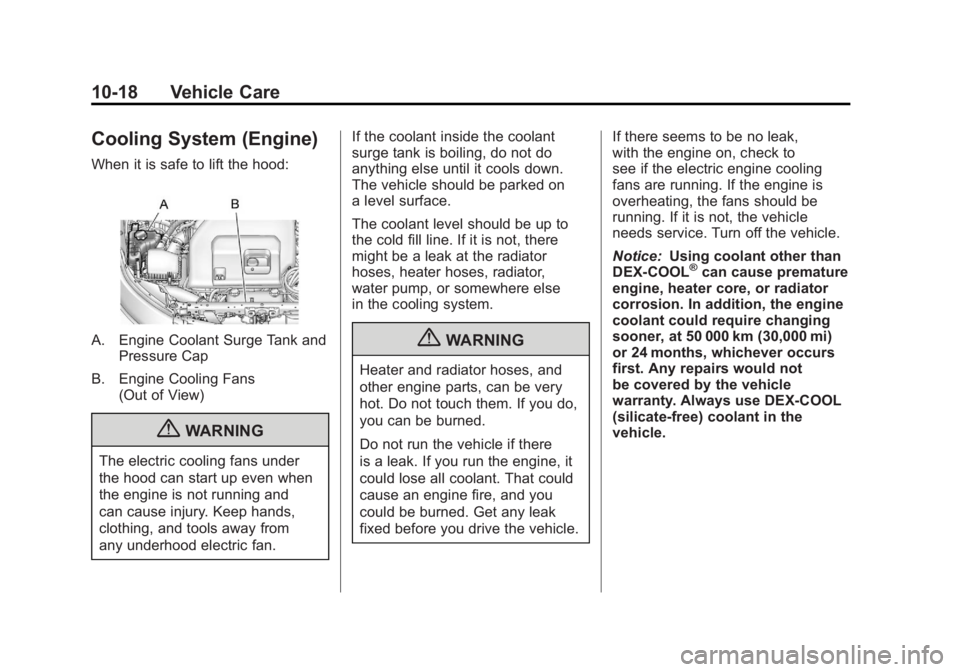
Black plate (18,1)Chevrolet Volt Owner Manual - 2011
10-18 Vehicle Care
Cooling System (Engine)
When it is safe to lift the hood:
A. Engine Coolant Surge Tank andPressure Cap
B. Engine Cooling Fans (Out of View)
{WARNING
The electric cooling fans under
the hood can start up even when
the engine is not running and
can cause injury. Keep hands,
clothing, and tools away from
any underhood electric fan. If the coolant inside the coolant
surge tank is boiling, do not do
anything else until it cools down.
The vehicle should be parked on
a level surface.
The coolant level should be up to
the cold fill line. If it is not, there
might be a leak at the radiator
hoses, heater hoses, radiator,
water pump, or somewhere else
in the cooling system.
{WARNING
Heater and radiator hoses, and
other engine parts, can be very
hot. Do not touch them. If you do,
you can be burned.
Do not run the vehicle if there
is a leak. If you run the engine, it
could lose all coolant. That could
cause an engine fire, and you
could be burned. Get any leak
fixed before you drive the vehicle.
If there seems to be no leak,
with the engine on, check to
see if the electric engine cooling
fans are running. If the engine is
overheating, the fans should be
running. If it is not, the vehicle
needs service. Turn off the vehicle.
Notice:
Using coolant other than
DEX-COOL
®can cause premature
engine, heater core, or radiator
corrosion. In addition, the engine
coolant could require changing
sooner, at 50 000 km (30,000 mi)
or 24 months, whichever occurs
first. Any repairs would not
be covered by the vehicle
warranty. Always use DEX-COOL
(silicate-free) coolant in the
vehicle.
Page 385 of 516
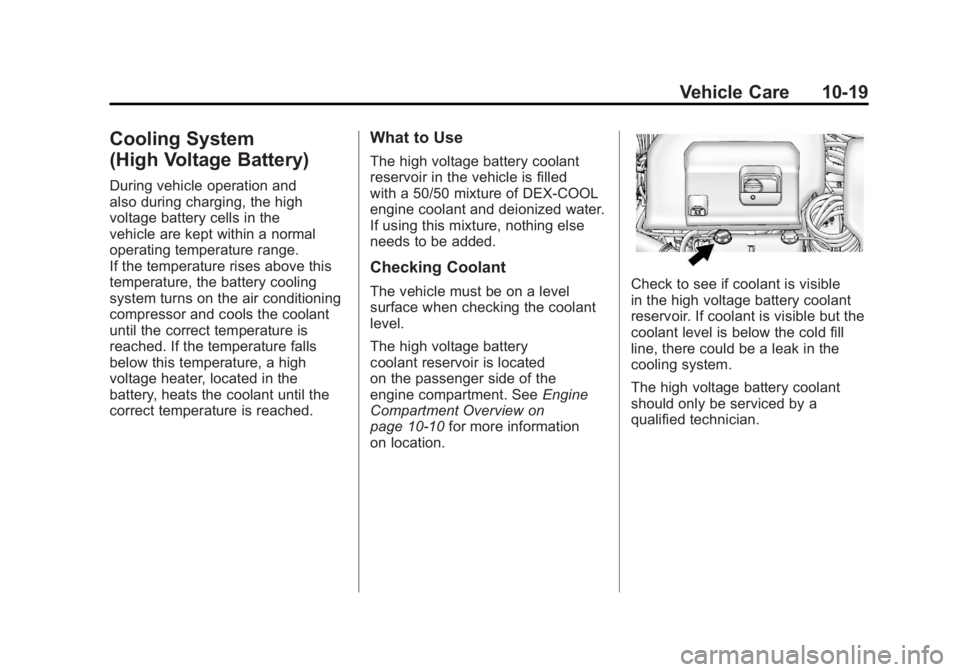
Black plate (19,1)Chevrolet Volt Owner Manual - 2011
Vehicle Care 10-19
Cooling System
(High Voltage Battery)
During vehicle operation and
also during charging, the high
voltage battery cells in the
vehicle are kept within a normal
operating temperature range.
If the temperature rises above this
temperature, the battery cooling
system turns on the air conditioning
compressor and cools the coolant
until the correct temperature is
reached. If the temperature falls
below this temperature, a high
voltage heater, located in the
battery, heats the coolant until the
correct temperature is reached.
What to Use
The high voltage battery coolant
reservoir in the vehicle is filled
with a 50/50 mixture of DEX-COOL
engine coolant and deionized water.
If using this mixture, nothing else
needs to be added.
Checking Coolant
The vehicle must be on a level
surface when checking the coolant
level.
The high voltage battery
coolant reservoir is located
on the passenger side of the
engine compartment. SeeEngine
Compartment Overview on
page 10‑10 for more information
on location.Check to see if coolant is visible
in the high voltage battery coolant
reservoir. If coolant is visible but the
coolant level is below the cold fill
line, there could be a leak in the
cooling system.
The high voltage battery coolant
should only be serviced by a
qualified technician.
Page 386 of 516
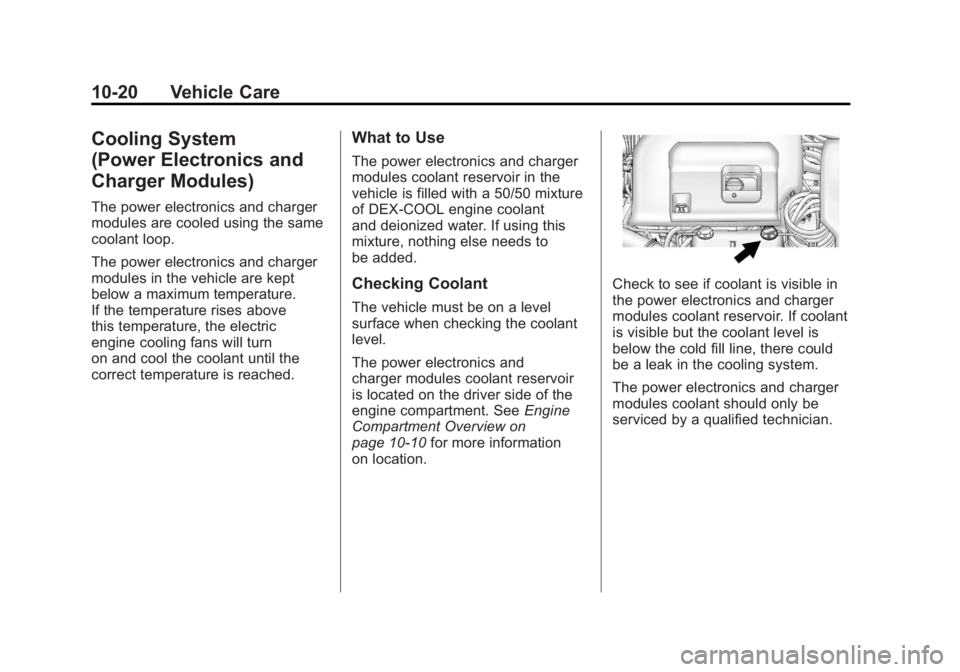
Black plate (20,1)Chevrolet Volt Owner Manual - 2011
10-20 Vehicle Care
Cooling System
(Power Electronics and
Charger Modules)
The power electronics and charger
modules are cooled using the same
coolant loop.
The power electronics and charger
modules in the vehicle are kept
below a maximum temperature.
If the temperature rises above
this temperature, the electric
engine cooling fans will turn
on and cool the coolant until the
correct temperature is reached.
What to Use
The power electronics and charger
modules coolant reservoir in the
vehicle is filled with a 50/50 mixture
of DEX-COOL engine coolant
and deionized water. If using this
mixture, nothing else needs to
be added.
Checking Coolant
The vehicle must be on a level
surface when checking the coolant
level.
The power electronics and
charger modules coolant reservoir
is located on the driver side of the
engine compartment. SeeEngine
Compartment Overview on
page 10‑10 for more information
on location.
Check to see if coolant is visible in
the power electronics and charger
modules coolant reservoir. If coolant
is visible but the coolant level is
below the cold fill line, there could
be a leak in the cooling system.
The power electronics and charger
modules coolant should only be
serviced by a qualified technician.
Page 387 of 516
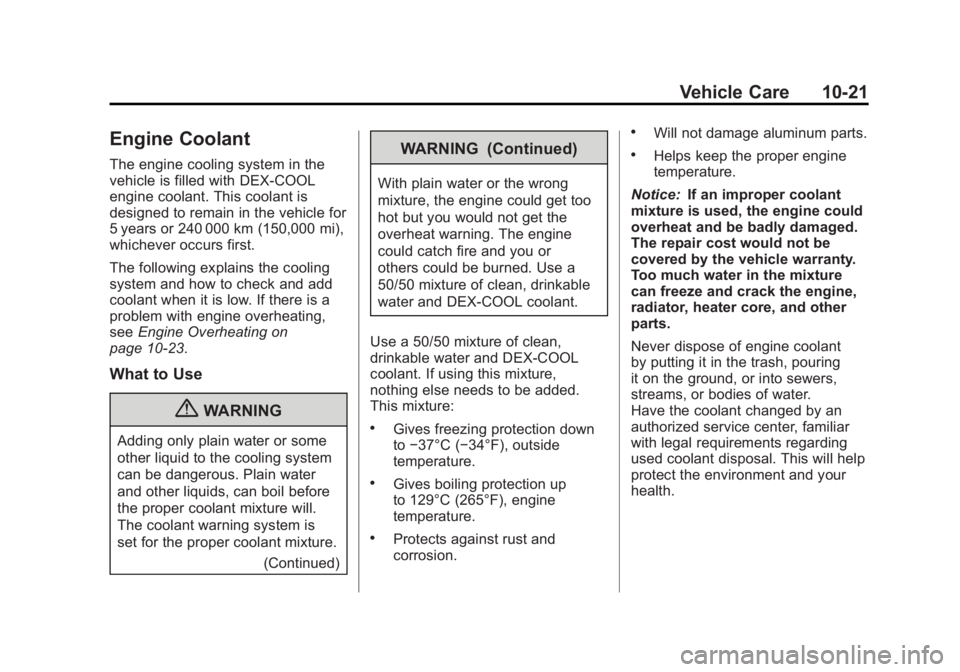
Black plate (21,1)Chevrolet Volt Owner Manual - 2011
Vehicle Care 10-21
Engine Coolant
The engine cooling system in the
vehicle is filled with DEX-COOL
engine coolant. This coolant is
designed to remain in the vehicle for
5 years or 240 000 km (150,000 mi),
whichever occurs first.
The following explains the cooling
system and how to check and add
coolant when it is low. If there is a
problem with engine overheating,
seeEngine Overheating on
page 10‑23.
What to Use
{WARNING
Adding only plain water or some
other liquid to the cooling system
can be dangerous. Plain water
and other liquids, can boil before
the proper coolant mixture will.
The coolant warning system is
set for the proper coolant mixture.
(Continued)
WARNING (Continued)
With plain water or the wrong
mixture, the engine could get too
hot but you would not get the
overheat warning. The engine
could catch fire and you or
others could be burned. Use a
50/50 mixture of clean, drinkable
water and DEX-COOL coolant.
Use a 50/50 mixture of clean,
drinkable water and DEX-COOL
coolant. If using this mixture,
nothing else needs to be added.
This mixture:
.Gives freezing protection down
to −37°C (−34°F), outside
temperature.
.Gives boiling protection up
to 129°C (265°F), engine
temperature.
.Protects against rust and
corrosion.
.Will not damage aluminum parts.
.Helps keep the proper engine
temperature.
Notice: If an improper coolant
mixture is used, the engine could
overheat and be badly damaged.
The repair cost would not be
covered by the vehicle warranty.
Too much water in the mixture
can freeze and crack the engine,
radiator, heater core, and other
parts.
Never dispose of engine coolant
by putting it in the trash, pouring
it on the ground, or into sewers,
streams, or bodies of water.
Have the coolant changed by an
authorized service center, familiar
with legal requirements regarding
used coolant disposal. This will help
protect the environment and your
health.
Page 388 of 516
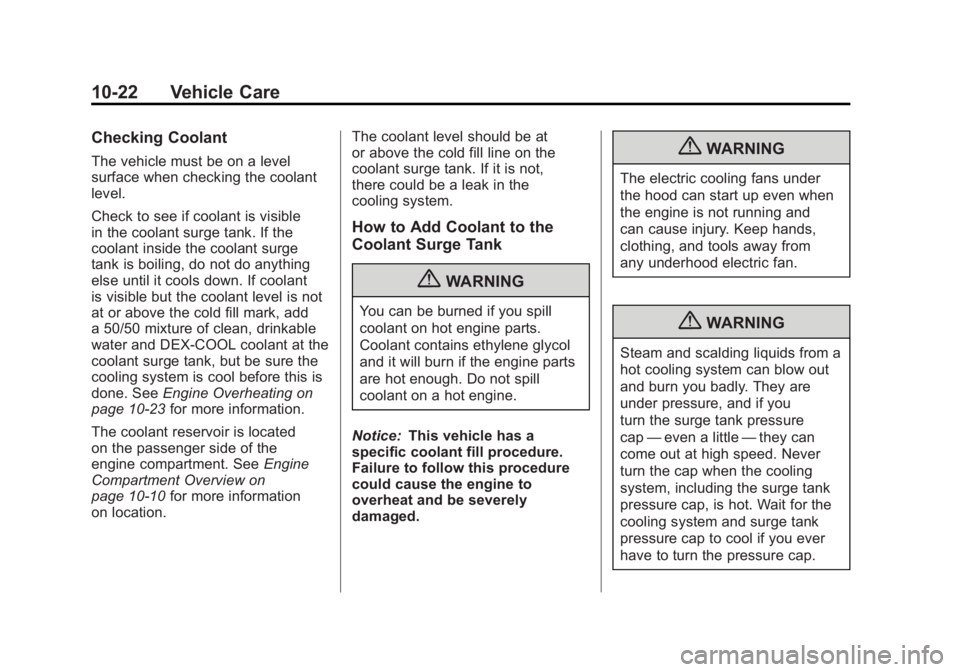
Black plate (22,1)Chevrolet Volt Owner Manual - 2011
10-22 Vehicle Care
Checking Coolant
The vehicle must be on a level
surface when checking the coolant
level.
Check to see if coolant is visible
in the coolant surge tank. If the
coolant inside the coolant surge
tank is boiling, do not do anything
else until it cools down. If coolant
is visible but the coolant level is not
at or above the cold fill mark, add
a 50/50 mixture of clean, drinkable
water and DEX-COOL coolant at the
coolant surge tank, but be sure the
cooling system is cool before this is
done. SeeEngine Overheating on
page 10‑23 for more information.
The coolant reservoir is located
on the passenger side of the
engine compartment. See Engine
Compartment Overview on
page 10‑10 for more information
on location. The coolant level should be at
or above the cold fill line on the
coolant surge tank. If it is not,
there could be a leak in the
cooling system.
How to Add Coolant to the
Coolant Surge Tank
{WARNING
You can be burned if you spill
coolant on hot engine parts.
Coolant contains ethylene glycol
and it will burn if the engine parts
are hot enough. Do not spill
coolant on a hot engine.
Notice: This vehicle has a
specific coolant fill procedure.
Failure to follow this procedure
could cause the engine to
overheat and be severely
damaged.
{WARNING
The electric cooling fans under
the hood can start up even when
the engine is not running and
can cause injury. Keep hands,
clothing, and tools away from
any underhood electric fan.
{WARNING
Steam and scalding liquids from a
hot cooling system can blow out
and burn you badly. They are
under pressure, and if you
turn the surge tank pressure
cap —even a little —they can
come out at high speed. Never
turn the cap when the cooling
system, including the surge tank
pressure cap, is hot. Wait for the
cooling system and surge tank
pressure cap to cool if you ever
have to turn the pressure cap.
Page 389 of 516
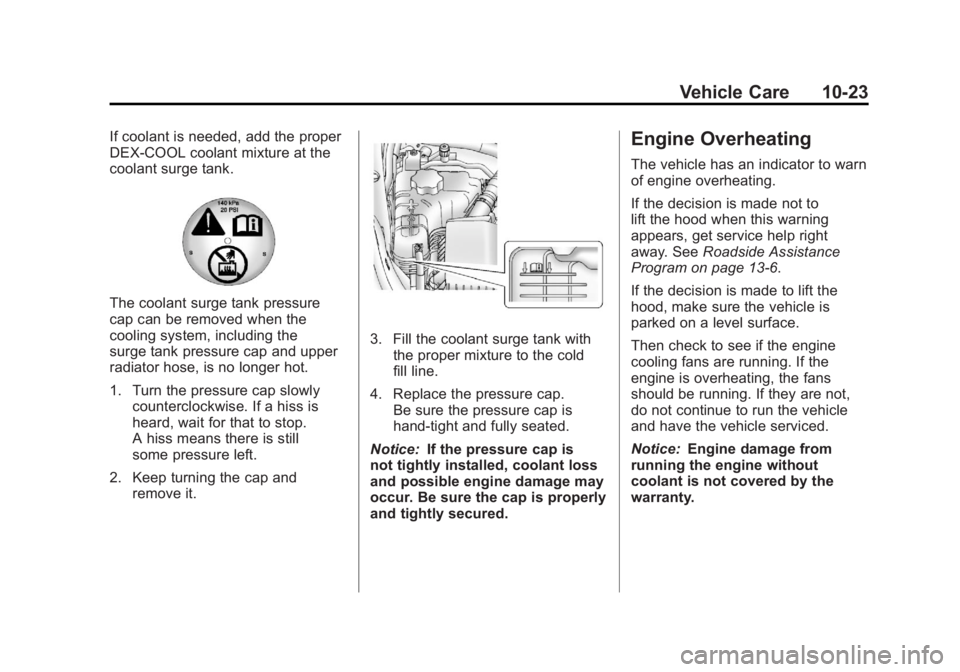
Black plate (23,1)Chevrolet Volt Owner Manual - 2011
Vehicle Care 10-23
If coolant is needed, add the proper
DEX-COOL coolant mixture at the
coolant surge tank.
The coolant surge tank pressure
cap can be removed when the
cooling system, including the
surge tank pressure cap and upper
radiator hose, is no longer hot.
1. Turn the pressure cap slowlycounterclockwise. If a hiss is
heard, wait for that to stop.
A hiss means there is still
some pressure left.
2. Keep turning the cap and remove it.
3. Fill the coolant surge tank with
the proper mixture to the cold
fill line.
4. Replace the pressure cap. Be sure the pressure cap is
hand‐tight and fully seated.
Notice: If the pressure cap is
not tightly installed, coolant loss
and possible engine damage may
occur. Be sure the cap is properly
and tightly secured.
Engine Overheating
The vehicle has an indicator to warn
of engine overheating.
If the decision is made not to
lift the hood when this warning
appears, get service help right
away. See Roadside Assistance
Program on page 13‑6.
If the decision is made to lift the
hood, make sure the vehicle is
parked on a level surface.
Then check to see if the engine
cooling fans are running. If the
engine is overheating, the fans
should be running. If they are not,
do not continue to run the vehicle
and have the vehicle serviced.
Notice: Engine damage from
running the engine without
coolant is not covered by the
warranty.
Page 393 of 516
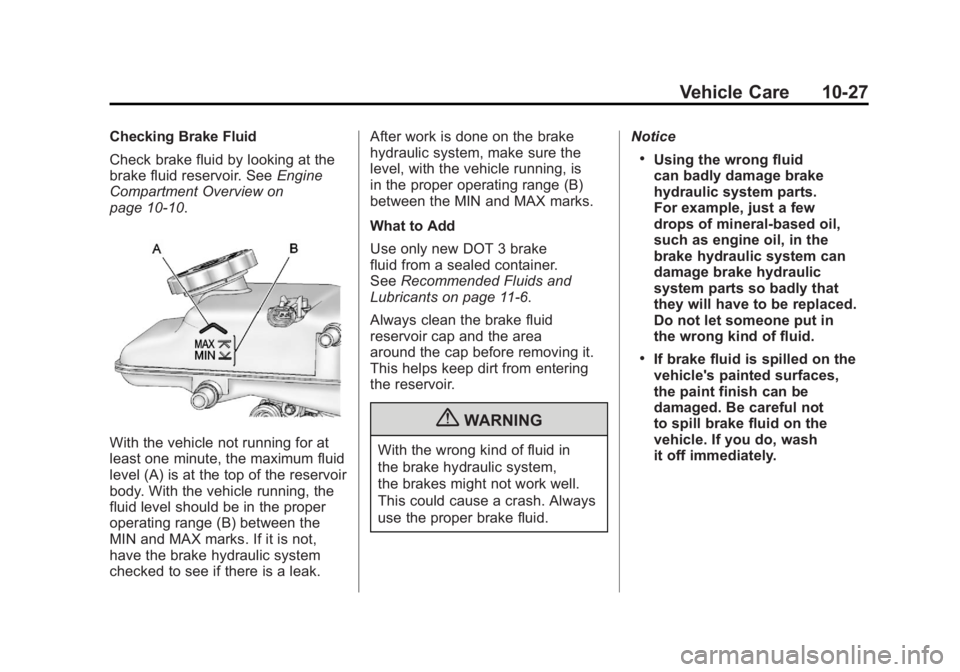
Black plate (27,1)Chevrolet Volt Owner Manual - 2011
Vehicle Care 10-27
Checking Brake Fluid
Check brake fluid by looking at the
brake fluid reservoir. SeeEngine
Compartment Overview on
page 10‑10.
With the vehicle not running for at
least one minute, the maximum fluid
level (A) is at the top of the reservoir
body. With the vehicle running, the
fluid level should be in the proper
operating range (B) between the
MIN and MAX marks. If it is not,
have the brake hydraulic system
checked to see if there is a leak. After work is done on the brake
hydraulic system, make sure the
level, with the vehicle running, is
in the proper operating range (B)
between the MIN and MAX marks.
What to Add
Use only new DOT 3 brake
fluid from a sealed container.
See
Recommended Fluids and
Lubricants on page 11‑6.
Always clean the brake fluid
reservoir cap and the area
around the cap before removing it.
This helps keep dirt from entering
the reservoir.
{WARNING
With the wrong kind of fluid in
the brake hydraulic system,
the brakes might not work well.
This could cause a crash. Always
use the proper brake fluid. Notice
.Using the wrong fluid
can badly damage brake
hydraulic system parts.
For example, just a few
drops of mineral-based oil,
such as engine oil, in the
brake hydraulic system can
damage brake hydraulic
system parts so badly that
they will have to be replaced.
Do not let someone put in
the wrong kind of fluid.
.If brake fluid is spilled on the
vehicle's painted surfaces,
the paint finish can be
damaged. Be careful not
to spill brake fluid on the
vehicle. If you do, wash
it off immediately.
Page 404 of 516

Black plate (38,1)Chevrolet Volt Owner Manual - 2011
10-38 Vehicle Care
If there is a problem on the road
and a fuse needs to be replaced,
the same amperage fuse can be
borrowed. Choose some feature of
the vehicle that is not needed to use
and replace it as soon as possible.
Headlamp Wiring
An electrical overload may cause
the lamps to go on and off, or in
some cases to remain off. Have
the headlamp wiring checked right
away if the lamps go on and off or
remain off.
Windshield Wipers
If the wiper motor overheats due to
heavy snow or ice, the windshield
wipers will stop until the motor cools
and the wiper control is turned off.
After removal of the blockage,
the wiper motor will restart when
the control is then moved to the
desired operating position.
Although the circuit is protected
from electrical overload, overload
due to heavy snow or ice, may
cause wiper linkage damage.
Always clear ice and heavy snow
from the windshield before using
the windshield wipers.
If the overload is caused by an
electrical problem and not snow
or ice, be sure to get it fixed.
Engine Compartment
Fuse Block
To open the fuse block cover, press
the clips at the front and back and
rotate the cover up to the side.
Notice:Spilling liquid on any
electrical component on the
vehicle may damage it. Always
keep the covers on any electrical
component.
Page 412 of 516

Black plate (46,1)Chevrolet Volt Owner Manual - 2011
10-46 Vehicle Care
A fuse puller is located in the engine
compartment fuse block.
The vehicle may not have all of the
fuses, relays, and features shown.Fuses Usage
F1 Empty
F2 Fuel System Control
Module Fuses Usage
F3 Passive Start
Module
F4 Heated Seats
(If Equipped)
F5 Driver Door
Switches (Outside
Rearview Mirror/
Charge Port Door
Release/Refuel
Request/Driver
Window Switch)
F6 Fuel (Diurnal
Valve and Evap.
Leak Check Module)
F7 Accessory Power
Module Cooling Fan
F8 Amplifier
(If Equipped)
F9 Empty
Page 449 of 516
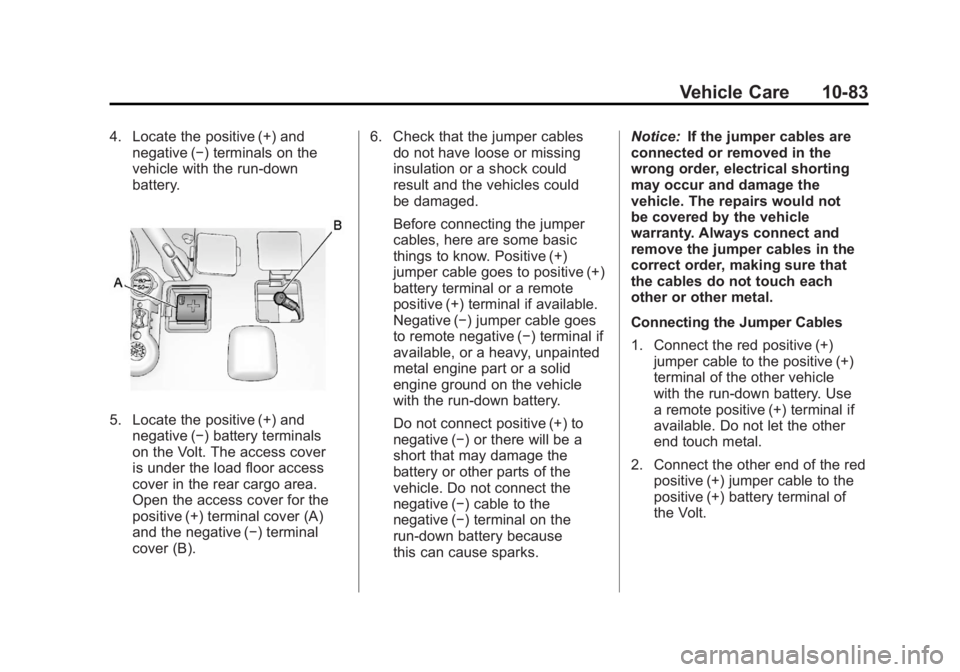
Black plate (83,1)Chevrolet Volt Owner Manual - 2011
Vehicle Care 10-83
4. Locate the positive (+) andnegative (−) terminals on the
vehicle with the run‐down
battery.
5. Locate the positive (+) and
negative (−) battery terminals
on the Volt. The access cover
is under the load floor access
cover in the rear cargo area.
Open the access cover for the
positive (+) terminal cover (A)
and the negative (−) terminal
cover (B). 6. Check that the jumper cables
do not have loose or missing
insulation or a shock could
result and the vehicles could
be damaged.
Before connecting the jumper
cables, here are some basic
things to know. Positive (+)
jumper cable goes to positive (+)
battery terminal or a remote
positive (+) terminal if available.
Negative (−) jumper cable goes
to remote negative (−) terminal if
available, or a heavy, unpainted
metal engine part or a solid
engine ground on the vehicle
with the run‐down battery.
Do not connect positive (+) to
negative (−) or there will be a
short that may damage the
battery or other parts of the
vehicle. Do not connect the
negative (−) cable to the
negative (−) terminal on the
run‐down battery because
this can cause sparks. Notice:
If the jumper cables are
connected or removed in the
wrong order, electrical shorting
may occur and damage the
vehicle. The repairs would not
be covered by the vehicle
warranty. Always connect and
remove the jumper cables in the
correct order, making sure that
the cables do not touch each
other or other metal.
Connecting the Jumper Cables
1. Connect the red positive (+) jumper cable to the positive (+)
terminal of the other vehicle
with the run‐down battery. Use
a remote positive (+) terminal if
available. Do not let the other
end touch metal.
2. Connect the other end of the red positive (+) jumper cable to the
positive (+) battery terminal of
the Volt.